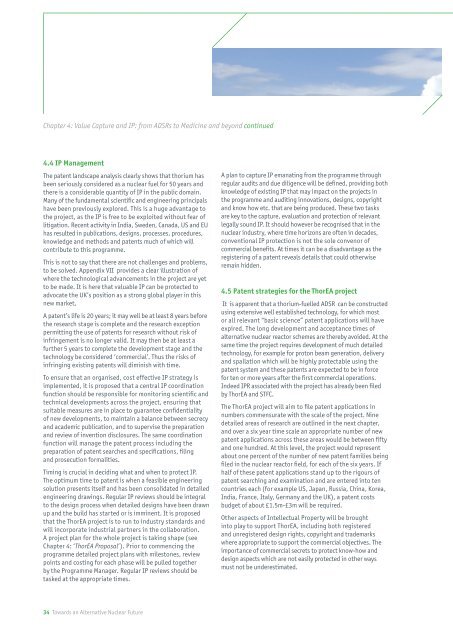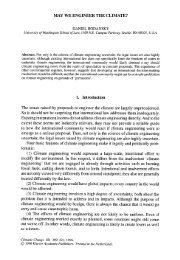ThorEA - Towards an Alternative Nuclear Future.pdf
ThorEA - Towards an Alternative Nuclear Future.pdf
ThorEA - Towards an Alternative Nuclear Future.pdf
You also want an ePaper? Increase the reach of your titles
YUMPU automatically turns print PDFs into web optimized ePapers that Google loves.
Chapter 4: Value Capture <strong>an</strong>d IP: from ADSRs to Medicine <strong>an</strong>d beyond continued<br />
4.4 IP M<strong>an</strong>agement<br />
The patent l<strong>an</strong>dscape <strong>an</strong>alysis clearly shows that thorium has<br />
been seriously considered as a nuclear fuel for 50 years <strong>an</strong>d<br />
there is a considerable qu<strong>an</strong>tity of IP in the public domain.<br />
M<strong>an</strong>y of the fundamental scientific <strong>an</strong>d engineering principals<br />
have been previously explored. This is a huge adv<strong>an</strong>tage to<br />
the project, as the IP is free to be exploited without fear of<br />
litigation. Recent activity in India, Sweden, C<strong>an</strong>ada, US <strong>an</strong>d EU<br />
has resulted in publications, designs, processes, procedures,<br />
knowledge <strong>an</strong>d methods <strong>an</strong>d patents much of which will<br />
contribute to this programme.<br />
This is not to say that there are not challenges <strong>an</strong>d problems,<br />
to be solved. Appendix VII provides a clear illustration of<br />
where the technological adv<strong>an</strong>cements in the project are yet<br />
to be made. It is here that valuable IP c<strong>an</strong> be protected to<br />
advocate the UK’s position as a strong global player in this<br />
new market.<br />
A patent’s life is 20 years; it may well be at least 8 years before<br />
the research stage is complete <strong>an</strong>d the research exception<br />
permitting the use of patents for research without risk of<br />
infringement is no longer valid. It may then be at least a<br />
further 5 years to complete the development stage <strong>an</strong>d the<br />
technology be considered ‘commercial’. Thus the risks of<br />
infringing existing patents will diminish with time.<br />
To ensure that <strong>an</strong> org<strong>an</strong>ised, cost effective IP strategy is<br />
implemented, it is proposed that a central IP coordination<br />
function should be responsible for monitoring scientific <strong>an</strong>d<br />
technical developments across the project, ensuring that<br />
suitable measures are in place to guar<strong>an</strong>tee confidentiality<br />
of new developments, to maintain a bal<strong>an</strong>ce between secrecy<br />
<strong>an</strong>d academic publication, <strong>an</strong>d to supervise the preparation<br />
<strong>an</strong>d review of invention disclosures. The same coordination<br />
function will m<strong>an</strong>age the patent process including the<br />
preparation of patent searches <strong>an</strong>d specifications, filing<br />
<strong>an</strong>d prosecution formalities.<br />
Timing is crucial in deciding what <strong>an</strong>d when to protect IP.<br />
The optimum time to patent is when a feasible engineering<br />
solution presents itself <strong>an</strong>d has been consolidated in detailed<br />
engineering drawings. Regular IP reviews should be integral<br />
to the design process when detailed designs have been drawn<br />
up <strong>an</strong>d the build has started or is imminent. It is proposed<br />
that the <strong>ThorEA</strong> project is to run to industry st<strong>an</strong>dards <strong>an</strong>d<br />
will incorporate industrial partners in the collaboration.<br />
A project pl<strong>an</strong> for the whole project is taking shape (see<br />
Chapter 4: ‘<strong>ThorEA</strong> Proposal’). Prior to commencing the<br />
programme detailed project pl<strong>an</strong>s with milestones, review<br />
points <strong>an</strong>d costing for each phase will be pulled together<br />
by the Programme M<strong>an</strong>ager. Regular IP reviews should be<br />
tasked at the appropriate times.<br />
34 <strong>Towards</strong> <strong>an</strong> <strong>Alternative</strong> <strong>Nuclear</strong> <strong>Future</strong><br />
A pl<strong>an</strong> to capture IP em<strong>an</strong>ating from the programme through<br />
regular audits <strong>an</strong>d due diligence will be defined, providing both<br />
knowledge of existing IP that may impact on the projects in<br />
the programme <strong>an</strong>d auditing innovations, designs, copyright<br />
<strong>an</strong>d know how etc. that are being produced. These two tasks<br />
are key to the capture, evaluation <strong>an</strong>d protection of relev<strong>an</strong>t<br />
legally sound IP. It should however be recognised that in the<br />
nuclear industry, where time horizons are often in decades,<br />
conventional IP protection is not the sole convenor of<br />
commercial benefits. At times it c<strong>an</strong> be a disadv<strong>an</strong>tage as the<br />
registering of a patent reveals details that could otherwise<br />
remain hidden.<br />
4.5 Patent strategies for the <strong>ThorEA</strong> project<br />
It is apparent that a thorium-fuelled ADSR c<strong>an</strong> be constructed<br />
using extensive well established technology, for which most<br />
or all relev<strong>an</strong>t “basic science” patent applications will have<br />
expired. The long development <strong>an</strong>d accept<strong>an</strong>ce times of<br />
alternative nuclear reactor schemes are thereby avoided. At the<br />
same time the project requires development of much detailed<br />
technology, for example for proton beam generation, delivery<br />
<strong>an</strong>d spallation which will be highly protectable using the<br />
patent system <strong>an</strong>d these patents are expected to be in force<br />
for ten or more years after the first commercial operations.<br />
Indeed IPR associated with the project has already been filed<br />
by <strong>ThorEA</strong> <strong>an</strong>d STFC.<br />
The <strong>ThorEA</strong> project will aim to file patent applications in<br />
numbers commensurate with the scale of the project. Nine<br />
detailed areas of research are outlined in the next chapter,<br />
<strong>an</strong>d over a six year time scale <strong>an</strong> appropriate number of new<br />
patent applications across these areas would be between fifty<br />
<strong>an</strong>d one hundred. At this level, the project would represent<br />
about one percent of the number of new patent families being<br />
filed in the nuclear reactor field, for each of the six years. If<br />
half of these patent applications st<strong>an</strong>d up to the rigours of<br />
patent searching <strong>an</strong>d examination <strong>an</strong>d are entered into ten<br />
countries each (for example US, Jap<strong>an</strong>, Russia, China, Korea,<br />
India, Fr<strong>an</strong>ce, Italy, Germ<strong>an</strong>y <strong>an</strong>d the UK), a patent costs<br />
budget of about £1.5m-£3m will be required.<br />
Other aspects of Intellectual Property will be brought<br />
into play to support <strong>ThorEA</strong>, including both registered<br />
<strong>an</strong>d unregistered design rights, copyright <strong>an</strong>d trademarks<br />
where appropriate to support the commercial objectives. The<br />
import<strong>an</strong>ce of commercial secrets to protect know-how <strong>an</strong>d<br />
design aspects which are not easily protected in other ways<br />
must not be underestimated.



